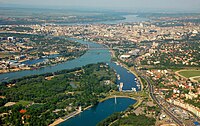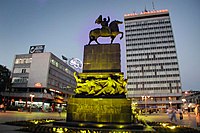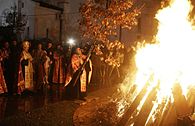Portal:Serbia/Selected article/Archive
Portal:Serbia/Selected article/January

An ala or hala (plural: ale) is a mythological creature recorded in the folklore of Bulgarians, Macedonians, and Serbs. Ale are considered demons of bad weather whose main purpose is to lead hail-producing thunderclouds in the direction of fields, vineyards, or orchards to destroy the crops, or loot and take them away. Extremely voracious, ale particularly like to eat children, though their gluttony is not limited to Earth. It is believed they can try to devour the Sun or the Moon causing eclipses; her success would mean the end of the world. When people encounter an ala, their mental or physical health, or even life, are in peril; however, her favor can be gained by approaching her with respect and trust. Being in a good relationship with an ala is very beneficial: she makes her favorites rich and saves their lives in times of trouble.
The appearance of ale is quite diversely and often vaguely described in folkloric sources. A given ala may look like a black wind, a gigantic creature of indistinct form, a huge-mouthed, humanlike, or snakelike monster, a female dragon, a raven, etc. By certain descriptions, ale can in fact assume various human or animal shapes, and can even possess a person’s body. This diversity is probably due to the fact that the ala is a synthesis of a Slavic demon of bad weather and a similar demon of the central Balkans pre-Slavic population. In folk tales with a humanlike ala, her personality is strikingly similar to that of the Russian Baba Yaga.

The Šajkača (Serbian Cyrillic: шајкача), the Serbian national hat, originated in the 18th century. It was originally worn by the Serbian river fleet in the service of the Habsburg Empire (known as the šajkaši) around the Danube and Sava Rivers. These men conducted small-scale raids against the Turks, thus allowing Serb refugees from the Ottoman Empire to safely flee to the Habsburg Empire. The refugees copied the design of the hat and spread it widely within the Serbian community.
The distinctive hat is recognisable by its top part that looks like the letter V or like the bottom of a boat (viewed from above), after which it got its name. It gained wide popularity in the early 20th century as it was the hat of the Serbian army in the First World War. It is still worn everyday by some villagers today, and it was worn among Bosnian Serb military commanders during the Bosnian War in the 1990s.
During the 1999 Kosovo War, the Belgrade branch of the American fast food chain McDonald's used the hat to promote itself (somewhat improbably) as an authentically Serbian entity, by distributing posters and lapel buttons showing the famous golden arches written in Cyrillic alphabet and surmounted by a šajkača.

The Serbian Academy of Sciences and Arts (Serbian: Српска академија наука и уметности / Srpska Akademija Nauka i Umetnosti; САНУ / SANU) is the most prominent academic institution in Serbia. Since the Serbian Academy of Sciences and Arts was founded by law (as the Serbian Royal Academy) of November 1, 1886, it has been the highest academic institution in Serbia. According to the Royal Academy Founding Act, King Milan was to appoint the first academic, who would then choose other members of the academy. The names of the first academics were announced by King Milan on April 5, 1887. At that time, there existed four sections in the academy, which were then called "specialised academies".
The Serbian Royal Academy was the successor to the Serbian Learned Society with which it merged in 1892 and accepted its members as its own either regular or honorary members, its tasks and its place in scientific and cultural life. The same had occurred several decades earlier when the Serbian Learned Society took over the place and functions of the Society of Serbian Letters, the first learned society in the Serbian Principality.
Today, the Academy directs a number of scientific research projects which are realized in cooperation with Serbian scientific institutions and through international cooperation.
Portal:Serbia/Selected article/May

Belgrade (/ˈbɛlɡreɪd/; Serbo-Croatian: Београд/Beograd; [beǒɡrad] ; names in other languages) is the capital and largest city of Serbia. It is located at the confluence of the Sava and Danube rivers, where the Pannonian Plain meets the Balkans. Its name translates to White city. The city has a population of 1.23 million, while over 1.65 million people live in its metro area (which encompass administrative limits of City of Belgrade).
One of the most important prehistoric cultures of Europe, the Vinča culture, evolved within the Belgrade area in the 6th millennium BC. In antiquity, Thraco-Dacians inhabited the region, and after 279 BC Celts conquered the city, naming it Singidūn. It was conquered by the Romans during the reign of Augustus, and awarded city rights in the mid 2nd century. It was settled by the Slavs in the 520s, and changed hands several times between the Byzantine Empire, Frankish Empire, Bulgarian Empire and Kingdom of Hungary before it became the capital of Serbian King Stephen Dragutin (1282–1316). In 1521, Belgrade was conquered by the Ottoman Empire and became the seat of the Sanjak of Smederevo. It frequently passed from Ottoman to Habsburg rule, which saw the destruction of most of the city during the Austro-Ottoman wars. Belgrade was again named the capital of Serbia in 1841. Northern Belgrade remained the southernmost Habsburg post until 1918, when the city was reunited. As a strategic location, the city was battled over in 115 wars and razed to the ground 44 times. Belgrade was the capital of Yugoslavia (in various forms of governments) from its creation in 1918, to its final dissolution in 2006.
Belgrade has a special administrative status within Serbia and it is one of five statistical regions of Serbia. Its metropolitan territory is divided into 17 municipalities, each with its own local council. It covers 3.6% of Serbia's territory, and 22.5% of the country's population lives in the city. The city has been awarded many titles, and the nomination for European Capital of Culture 2020.

Novi Sad (Cyrillic: Нови Сад, Serbo-Croatian pronunciation: [ˈnɔviː ˈsaːd], ; Hungarian: Újvidék; Slovak: Nový Sad; Rusyn: Нови Сад) is the capital of the northern Serbian province of Vojvodina, and the administrative centre of the South Bačka District.
According to the 2002 Census, Novi Sad is Serbia's third-largest town (including Kosovo), after Belgrade and Priština, with its 300,000 inhabitants. In its most recent official census from 2002, the city had an urban population of 216,583, while its municipal population was 299,294. The city is located on the border of the Bačka and Syrmia regions, on the banks of the Danube river and Danube-Tisa-Danube Canal, while facing the northern slopes of Fruška Gora mountain.
Since it was founded in 1694, Novi Sad became the centre of Serbian culture and earned its nickname Serbian Athens. Today, Novi Sad is a large industrial and financial centre of the Serbian economy; and it is also one of the biggest construction sites in the region.

Belgrade (Serbian: Београд, Beograd ), is the capital and largest city of Serbia. The city lies at the confluence of the Sava and Danube Rivers in north central Serbia, where the Pannonian Plain meets the Balkan Peninsula. With a population of over 1.9 million (estimate 2008), Belgrade is the largest city in the territory of the former Yugoslavia and the fourth largest in Southeastern Europe, after Istanbul, Athens, and Bucharest.
One of Europe's oldest cities, with a history of 7,000 years Belgrade's wider city area was the birthplace of the largest prehistoric culture of Europe, the Vinča culture. The foundation of the city itself dates back to Celtic and later, Roman periods, followed by the settlement of Slavs around the 7th century. In medieval times, it was in the possession of Byzantine, Frankish, Bulgarian, Hungarian and Serbian rulers, until it was conquered by the Ottomans in 1521 and became the seat of the Pashaluk of Belgrade. It became the capital of an independent Serbian state for the first time in 1284 (lost to Hungary in 1427), the status that it would regain only in 1841, after the liberation from the Ottomans. In the 20th century, it was also the capital of several incarnations of Yugoslavia, up to 2006, when Serbia became an independent state again.
Belgrade has the status of a separate territorial unit in Serbia, with its own autonomous city government. Its territory is divided into 17 municipalities, each having its own local council. It covers 3.6% of the territory of Serbia, and 21% of the Serbian population lives in the city. Belgrade is the central economic hub of Serbia, and the capital of Serbian culture, education and science.

Niš (Serbian: Ниш / Niš, Serbo-Croatian pronunciation: [niːʃ] ) is a city in Serbia situated at 43.3° N 21.9° E, on the river Nišava. With more than 250,000 inhabitants it is the largest city of South Serbia and third-largest city in the country, after Belgrade and Novi Sad. The city covers an area of about 597 square kilometres, including the city of Niš itself, the Niška Banja spa and 68 suburbs. Niš Constantine the Great Airport (Аеродром Константин Велики) is its international airport with the destination code INI. Niš is the administrative center of the Nišava District of Serbia.
Situated at crossroads of Balkan and Central European highways, connecting Asia Minor to Europe, Niš is one of the oldest cities in the Balkans, and has from ancient times been considered a gateway between the East and the West. It is home to one of Serbia's oldest Christian churches dating to the 4th century in the suburb of Mediana. Niš is also notable as the birthplace of Constantine the Great, the first Christian Roman Emperor and the founder of Constantinople, as well as two other Roman emperors, Constantius III and Justin I.
Niš is a university center. There are about 30,000 university students at the University of Niš, which comprises 13 faculties. Niš is also one of the most important industrial centres in Serbia, a center of electronics industry (see Elektronska Industrija Niš), industry of mechanical engineering, textile industry and tobacco industry.

The Serbian Campaign (World War I) was fought from August 1914, when Austria-Hungary invaded Serbia at the outset of First World War, until the end of the war in 1918. The front ranged from the Danube to southern Macedonia and back north again, involving forces from almost all combatants of the war.
The Serbian Army was decimated towards the end of the war, falling from about 420,000 at its peak to about 100,000 at the moment of liberation. The Kingdom of Serbia had lost 725,000 inhabitants during the war (both army and civilian losses), which represented over 16% of its overall population. (According to the Yugoslav government in 1924: Serbia lost 365,164 soldiers, or 26 percent, of all mobilized people [for ex. France 16.8; Germany 15.4; Russia 11.5; Italy 10.3 per cent]).
World War I was, in at least one sense, started when Chief of Serbian Military Intelligence Dragutin Dimitriević ordered the assassination of Archduke Franz Ferdinand heir to the throne of Austria-Hungary. Dimitriević's right hand man, Major Tankosić armed and trained three assassins and arranged for their clandestine transport across the border and to Sarajevo. In Sarajevo, Danilo Ilić had been alerted by Belgrade to arrange additional local assassins and he recruited an additional three arming them with the weapons brought from Belgrade. The attack killed the archduke and his wife and wounded 20. The assassins were arrested and gave up the names of the many Serbian military officers who had helped them on their way. Austria-Hungary requested Serbia open an investigation parallel to their own on Serbian soil, but Serbia flatly rejected the request.

The badnjak (Cyrillic: бадњак, Serbian pronunciation: [ˈbǎdɲaːk]), also called veseljak (весељак, [ʋɛˈsɛ̌ʎaːk], literally "jovial one" in Serbian), is represented by three types of objects in Serbian Christmas celebrations. The oldest type is a log brought into the house and placed on the fire on the evening of Christmas Eve, much like a yule log in other European traditions. The tree from which the log is cut, preferably a young and straight oak, is ceremonially felled early on the morning of Christmas Eve. The felling, preparation, bringing in, and laying on the fire, are surrounded by elaborate rituals, with many regional variations. The burning of the log is accompanied by prayers that the coming year brings food, happiness, love, luck, and riches. The log burns on throughout Christmas Day, when the first visitor strikes it with a poker or a branch to make sparks fly, requesting that the family's happiness and prosperity be as abundant as the sparks. Another type of the badnjak that has developed among the Serbs has mostly replaced the traditional log, whose burning is usually unfeasible in modern homes. It is a cluster of oak twigs with brown leaves attached, with which the home is decorated on the Eve.
